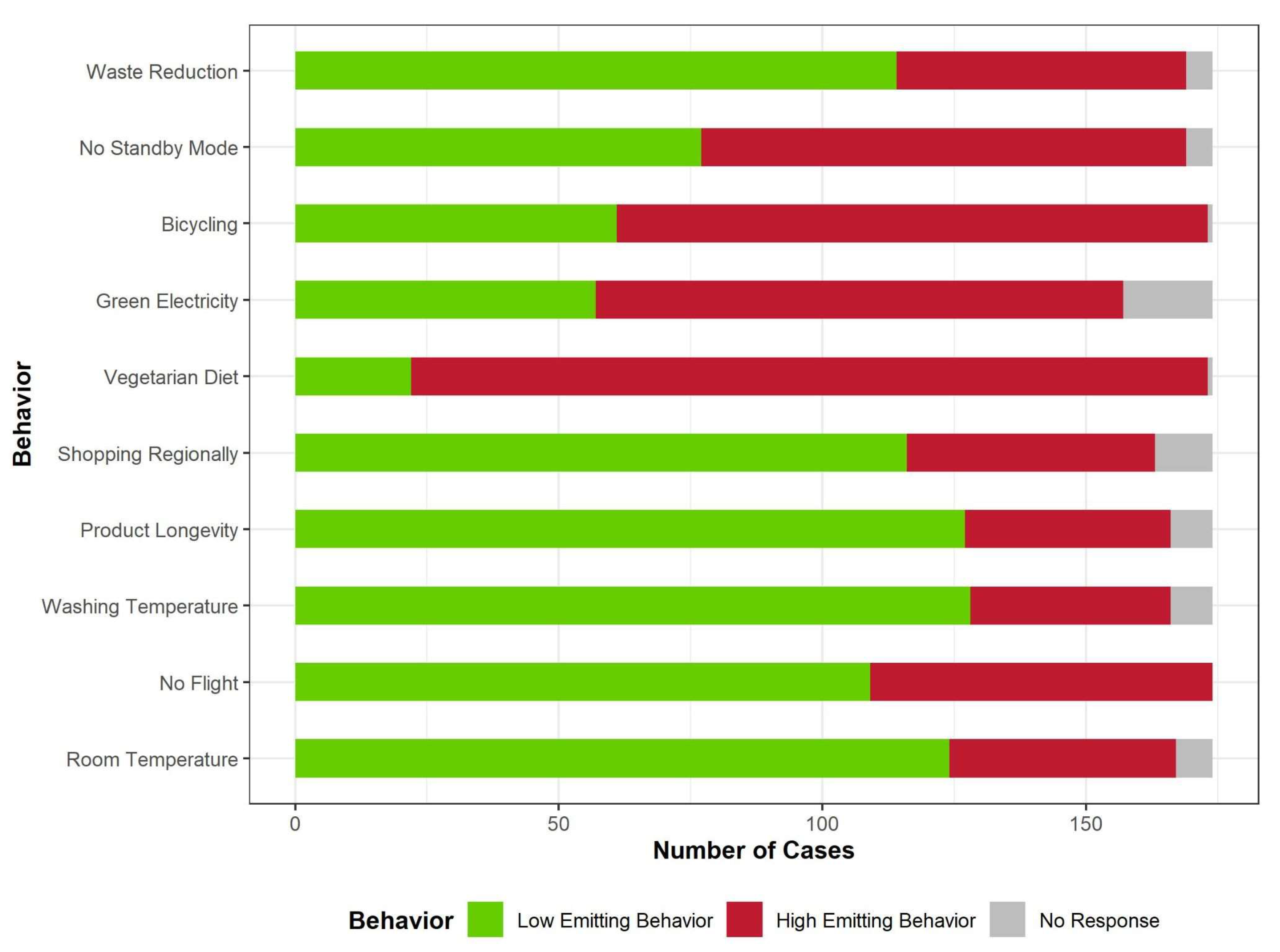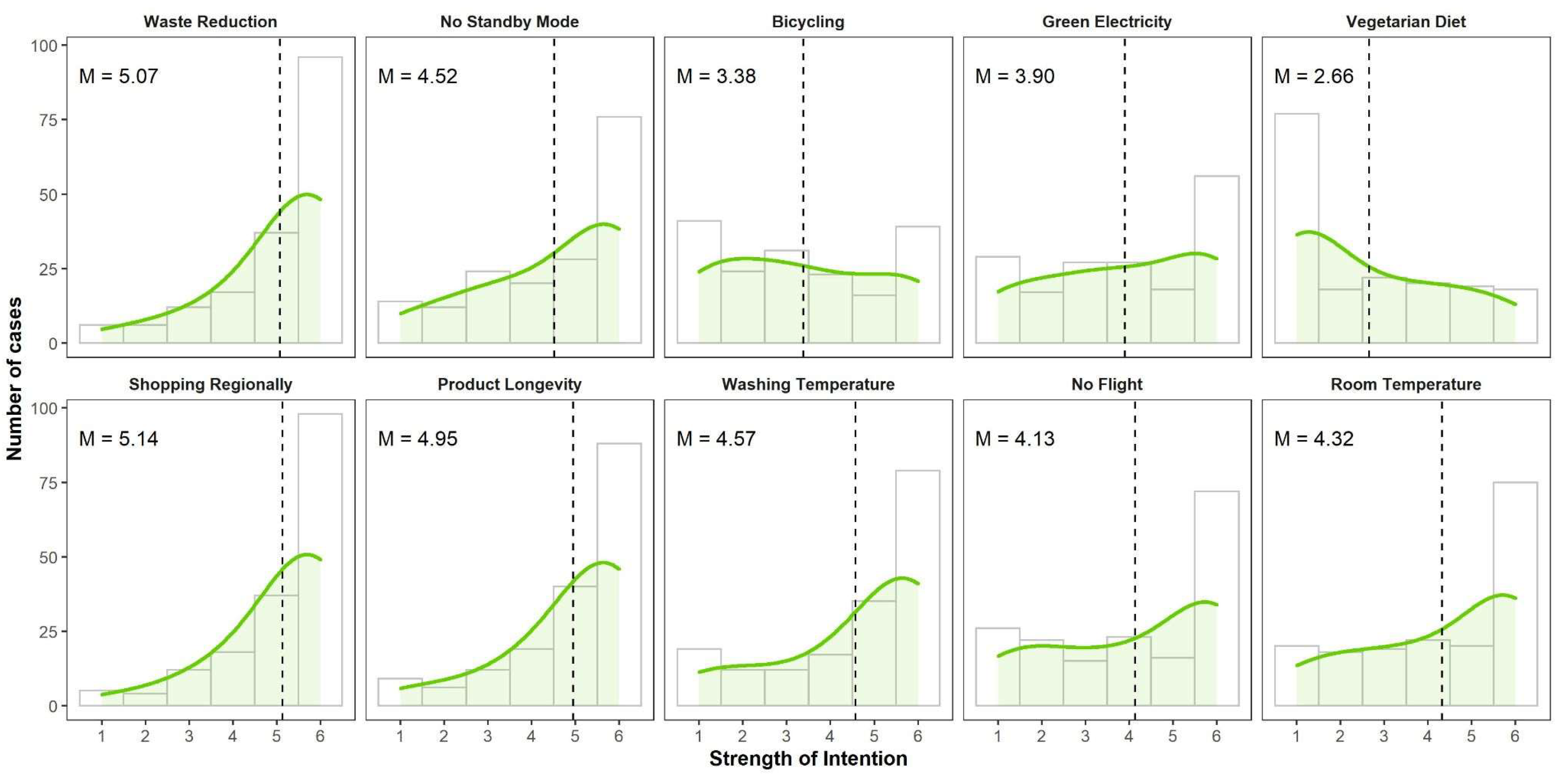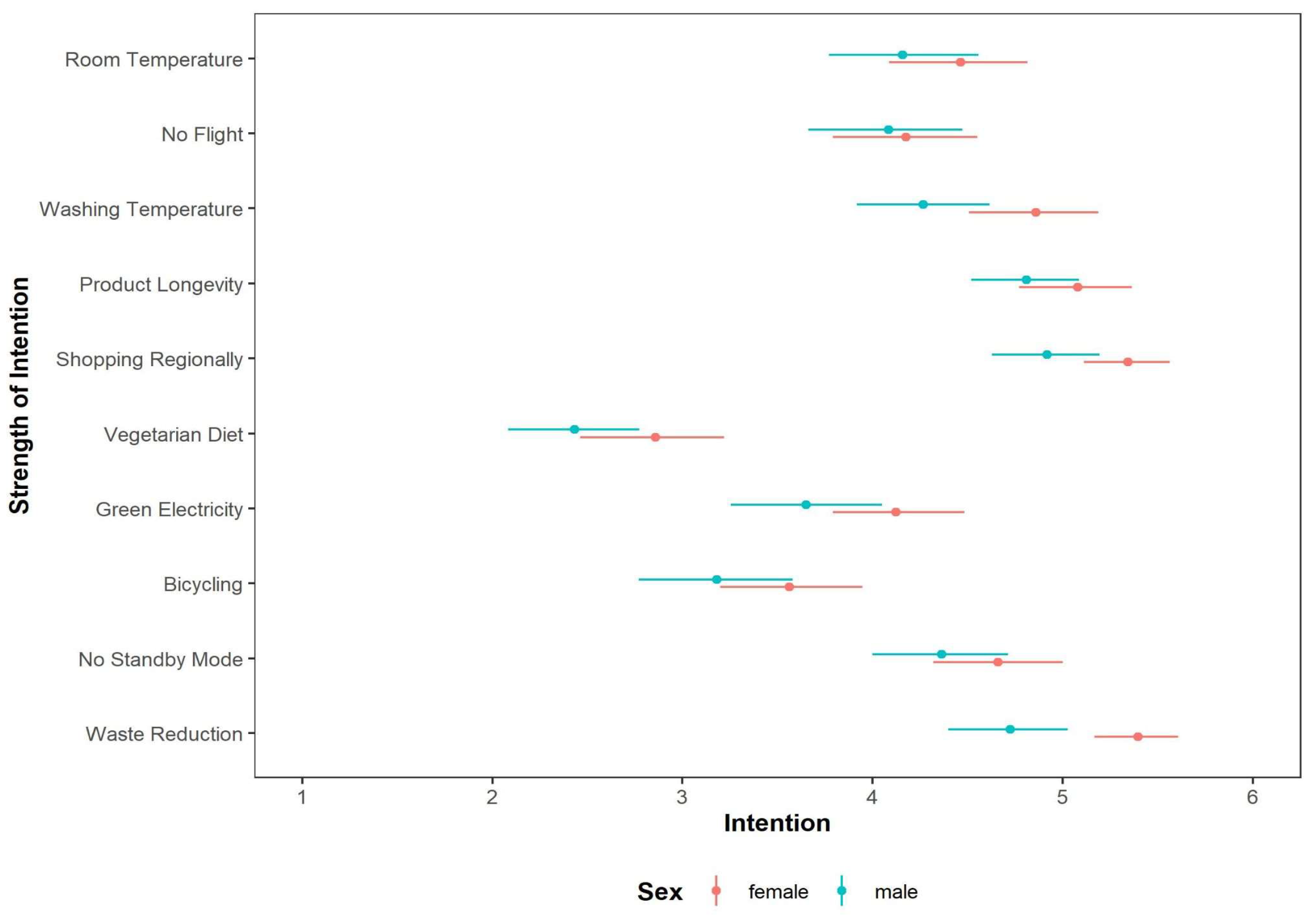Distinguishing between Low- and High-Cost Pro-Environmental Behavior: Empirical Evidence from Two Complementary Studies
Abstract
1. Introduction
2. Materials and Methods
2.1. Survey Design, Procedure, and Sample
2.2. Design, Procedure, and Samples of the Gamification Intervention
3. Results
3.1. Representative Survey
3.2. Gamification Intervention
3.2.1. Consumption
3.2.2. Housing (Energy/Heating)
3.2.3. Mobility
3.2.4. Food/Diet
3.2.5. Pro-Environmental Activities
3.2.6. Additional Aspects from Feedback
3.3. Cross-Design Synthesis
4. Discussion
5. Conclusions
Author Contributions
Funding
Institutional Review Board Statement
Informed Consent Statement
Data Availability Statement
Conflicts of Interest
Correction Statement
Appendix A
References
- United Nations. General Assembly Resolution A/RES/70/1: Transforming Our World, the 2030 Agenda for Sustainable Development; United Nations: New York, NY, USA, 2015. [Google Scholar]
- German Federal Government. German Sustainable Development Strategy; Update 2021; Bundesregierung: Berlin, Germany, 2021.
- Kollmuss, A.; Agyeman, J. Mind the Gap: Why do people act environmentally and what are the barriers to pro-environmental behavior? Environ. Educ. Res. 2002, 8, 239–260. [Google Scholar] [CrossRef]
- Bundesministerium für Umwelt, Naturschutz und Nukleare Sicherheit. Klimaschutz in Zahlen—Fakten, Trends und Impulse Deutscher Klimapolitik; Ausgabe 2018; Bundesministerium für Umwelt, Naturschutz und Nukleare Sicherheit (BMU): Bonn, Germany, 2018.
- Happer, C.; Philo, G. New approaches to understanding the role of the news media in the formation of public attitudes and behaviours on climate change. Eur. J. Commun. 2016, 31, 136–151. [Google Scholar] [CrossRef]
- Malan, H.; Amsler Challamel, G.; Silverstein, D.; Hoffs, C.; Spang, E.; Pace, S.A.; Malagueño, B.L.R.; Gardner, C.D.; Wang, M.C.; Slusser, W.; et al. Impact of a Scalable, Multi-Campus “Foodprint” Seminar on College Students’ Dietary Intake and Dietary Carbon Footprint. Nutrients 2020, 12, 2890. [Google Scholar] [CrossRef] [PubMed]
- Matsui, K.; Ochiai, H.; Yamagata, Y. Feedback on electricity usage for home energy management: A social experiment in a local village of cold region. Appl. Energy 2014, 120, 159–168. [Google Scholar] [CrossRef]
- West, S.; van Kerkhoff, L.; Wagenaar, H. Beyond “linking knowledge and action”: Towards a practice-based approach to transdisciplinary sustainability interventions. Policy Stud. 2019, 40, 534–555. [Google Scholar] [CrossRef]
- Klöckner, C.A. A comprehensive model of the psychology of environmental behaviour—A meta-analysis. Glob. Environ. Chang. 2013, 23, 1028–1038. [Google Scholar] [CrossRef]
- Ivanova, D.; Barrett, J.; Wiedenhofer, D.; Macura, B.; Callaghan, M.; Creutzig, F. Quantifying the potential for climate change mitigation of consumption options. Environ. Res. Lett. 2020, 15, 93001. [Google Scholar] [CrossRef]
- Nisa, C.F.; Bélanger, J.J.; Schumpe, B.M.; Faller, D.G. Meta-analysis of randomised controlled trials testing behavioural interventions to promote household action on climate change. Nat. Commun. 2019, 10, 4545. [Google Scholar] [CrossRef] [PubMed]
- Osbaldiston, R.; Schott, J.P. Environmental Sustainability and Behavioral Science:Meta-Analysis of Proenvironmental Behavior Experiments. Environ. Behav. 2012, 44, 257–299. [Google Scholar] [CrossRef]
- Diekmann, A.; Preisendörfer, P. Green and Greenback:The Behavioral Effects of Environmental Attitudes in Low-Cost and High-Cost Situations. Ration. Soc. 2003, 15, 441–472. [Google Scholar] [CrossRef]
- Steg, L.; de Groot, J.I.M.; Dreijerink, L.; Abrahamse, W.; Siero, F. General Antecedents of Personal Norms, Policy Acceptability, and Intentions: The Role of Values, Worldviews, and Environmental Concern. Soc. Nat. Resour. 2011, 24, 349–367. [Google Scholar] [CrossRef]
- Stern, P.C.; Dietz, T.; Abel, T.; Guagnano, G.A.; Kalof, L. A value-belief-norm theory of support for social movements: The case of environmentalism. Hum. Ecol. Rev. 1999, 6, 81–97. [Google Scholar]
- Lundberg, D.C.; Tang, J.A.; Attari, S.Z. Easy but not effective: Why “turning off the lights” remains a salient energy conserving behaviour in the United States. Energy Res. Soc. Sci. 2019, 58, 101257. [Google Scholar] [CrossRef]
- Rau, H.; Nicolai, S.; Stoll-Kleemann, S. Die Nachhaltigkeitschallenge. LBzM 2022, 22, 1–11. [Google Scholar] [CrossRef]
- Stoll-Kleemann, S.; Franikowski, P.; Nicolai, S. Development and Validation of a Scale to Assess Moral Disengagement in High-Carbon Behavior. Sustainability 2023, 15, 2054. [Google Scholar] [CrossRef]
- Leiner, D.J. Too Fast, too Straight, too Weird: Non-Reactive Indicators for Meaningless Data in Internet Surveys. Surv. Res. Methods 2019, 13, 229–248. [Google Scholar] [CrossRef]
- Satow, L. Skala zur Erfassung von Testverfälschung durch Positive Selbstdarstellung und Sozialerwünschte Antworttendenzen (SEA); Elektronisches Testarchiv; Leibniz-Zentrum für Psychologische Information und Dokumentation (ZPID): Trier, Germany, 2012. [Google Scholar] [CrossRef]
- Rau, H.; Nicolai, S.; Stoll-Kleemann, S. A systematic review to assess the evidence-based effectiveness, content, and success factors of behavior change interventions for enhancing pro-environmental behavior in individuals. Front. Psychol. 2022, 13, 901927. [Google Scholar] [CrossRef] [PubMed]
- Abrahamse, W. Encouraging Pro-Environmental Behaviour: What Works, What Doesn’t, and Why; Academic Press: Cambridge, MA, USA, 2019; ISBN 978-0128113592. [Google Scholar]
- Cellina, F.; Bucher, D.; Mangili, F.; Veiga Simão, J.; Rudel, R.; Raubal, M. A Large Scale, App-Based Behaviour Change Experiment Persuading Sustainable Mobility Patterns: Methods, Results and Lessons Learnt. Sustainability 2019, 11, 2674. [Google Scholar] [CrossRef]
- Schawel, C.; Billing, F. BCG-Matrix. In Top 100 Management Tools; Schawel, C., Billing, F., Eds.; Gabler Verlag: Wiesbaden, Germany, 2012; pp. 32–34. ISBN 978-3-8349-4104-6. [Google Scholar]
- Wynes, S.; Nicholas, K.A.; Zhao, J.; Donner, S.D. Measuring what works: Quantifying greenhouse gas emission reductions of behavioural interventions to reduce driving, meat consumption, and household energy use. Environ. Res. Lett. 2018, 13, 113002. [Google Scholar] [CrossRef]
- Stoll-Kleemann, S.; Schmidt, U.J. Reducing meat consumption in developed and transition countries to counter climate change and biodiversity loss: A review of influence factors. Reg. Environ. Chang. 2017, 17, 1261–1277. [Google Scholar] [CrossRef]
- Kurz, V. Nudging to reduce meat consumption: Immediate and persistent effects of an intervention at a university restaurant. J. Environ. Econ. Manag. 2018, 90, 317–341. [Google Scholar] [CrossRef]
- Kelly, N.R.; Mazzeo, S.E.; Bean, M.K. Systematic Review of Dietary Interventions with College Students: Directions for Future Research and Practice. J. Nutr. Educ. Behav. 2013, 45, 304–313. [Google Scholar] [CrossRef]
- Klöckner, C.A.; Ofstad, S.P. Tailored information helps people progress towards reducing their beef consumption. J. Environ. Psychol. 2017, 50, 24–36. [Google Scholar] [CrossRef]
- Williamson, K.; Satre-Meloy, A.; Velasco, K.; Green, K. Climate Change Needs Behavior Change: Making the Case for Behavioral Solutions to Reduce Global Warming; Rare: Arlington, VA, USA, 2018. [Google Scholar]
- Marchand, R.D.; Koh, S.C.L.; Morris, J.C. Delivering energy efficiency and carbon reduction schemes in England: Lessons from Green Deal Pioneer Places. Energy Policy 2015, 84, 96–106. [Google Scholar] [CrossRef]
- Benka-Coker, M.L.; Tadele, W.; Milano, A.; Getaneh, D.; Stokes, H. A case study of the ethanol CleanCook stove intervention and potential scale-up in Ethiopia. Energy Sustain. Dev. 2018, 46, 53–64. [Google Scholar] [CrossRef]
- Büchs, M.; Bahaj, A.S.; Blunden, L.; Bourikas, L.; Falkingham, J.; James, P.; Kamanda, M.; Wu, Y. Promoting low carbon behaviours through personalised information? Long-term evaluation of a carbon calculator interview. Energy Policy 2018, 120, 284–293. [Google Scholar] [CrossRef]
- Carrico, A.R.; Riemer, M. Motivating energy conservation in the workplace: An evaluation of the use of group-level feedback and peer education. J. Environ. Psychol. 2011, 31, 1–13. [Google Scholar] [CrossRef]
- Revell, K. Estimating the environmental impact of home energy visits and extent of behaviour change. Energy Policy 2014, 73, 461–470. [Google Scholar] [CrossRef]
- Schäfer, M.; Jaeger-Erben, M.; Bamberg, S. Life Events as Windows of Opportunity for Changing Towards Sustainable Consumption Patterns? J. Consum. Policy 2012, 35, 65–84. [Google Scholar] [CrossRef]
- Pröpsting, S.; Both, J. Nachhaltige Schülerfirmen als Reallabore für Lernen durch Engagement und die Potenziale neuer Medien. In Nachhaltigkeit Erfahren—Engagement als Schlüssel Einer Bildung für Nachhaltige Entwicklung; Bittner, A., Pyhel, T., Bischoff, V., Eds.; Oekom Verlag: Munich, Germany, 2016; ISBN 978-3-86581-819-5. [Google Scholar]
- Iweka, O.; Liu, S.; Shukla, A.; Yan, D. Energy and behaviour at home: A review of intervention methods and practices. Energy Res. Soc. Sci. 2019, 57, 101238. [Google Scholar] [CrossRef]
- Gardner, G.T.; Stern, P.C. Environmental Problems and Human Behavior; Pearson Learning Solution: Needham Heights, MA, USA, 1996. [Google Scholar]
- Lorenzoni, I.; Nicholson-Cole, S.; Whitmarsh, L. Barriers perceived to engaging with climate change among the UK public and their policy implications. Glob. Environ. Chang. 2007, 17, 445–459. [Google Scholar] [CrossRef]
- Andersson, A.; Winslott Hiselius, L.; Adell, E. Promoting sustainable travel behaviour through the use of smartphone applications: A review and development of a conceptual model. Travel Behav. Soc. 2018, 11, 52–61. [Google Scholar] [CrossRef]




Quadrant II—high intention, low shown behavior (rather-low-cost PEB)
| Quadrant I—high intention, high shown behavior (low-cost PEB)
|
Quadrant III—low intention, low shown behavior (high-cost PEB)
| Quadrant IV—low intention, high shown behavior (rather-high-cost PEB)
|
Disclaimer/Publisher’s Note: The statements, opinions and data contained in all publications are solely those of the individual author(s) and contributor(s) and not of MDPI and/or the editor(s). MDPI and/or the editor(s) disclaim responsibility for any injury to people or property resulting from any ideas, methods, instructions or products referred to in the content. |
© 2024 by the authors. Licensee MDPI, Basel, Switzerland. This article is an open access article distributed under the terms and conditions of the Creative Commons Attribution (CC BY) license (https://creativecommons.org/licenses/by/4.0/).
Share and Cite
Rau, H.; Nicolai, S.; Franikowski, P.; Stoll-Kleemann, S. Distinguishing between Low- and High-Cost Pro-Environmental Behavior: Empirical Evidence from Two Complementary Studies. Sustainability 2024, 16, 2206. https://doi.org/10.3390/su16052206
Rau H, Nicolai S, Franikowski P, Stoll-Kleemann S. Distinguishing between Low- and High-Cost Pro-Environmental Behavior: Empirical Evidence from Two Complementary Studies. Sustainability. 2024; 16(5):2206. https://doi.org/10.3390/su16052206
Chicago/Turabian StyleRau, Henriette, Susanne Nicolai, Philipp Franikowski, and Susanne Stoll-Kleemann. 2024. "Distinguishing between Low- and High-Cost Pro-Environmental Behavior: Empirical Evidence from Two Complementary Studies" Sustainability 16, no. 5: 2206. https://doi.org/10.3390/su16052206
APA StyleRau, H., Nicolai, S., Franikowski, P., & Stoll-Kleemann, S. (2024). Distinguishing between Low- and High-Cost Pro-Environmental Behavior: Empirical Evidence from Two Complementary Studies. Sustainability, 16(5), 2206. https://doi.org/10.3390/su16052206






